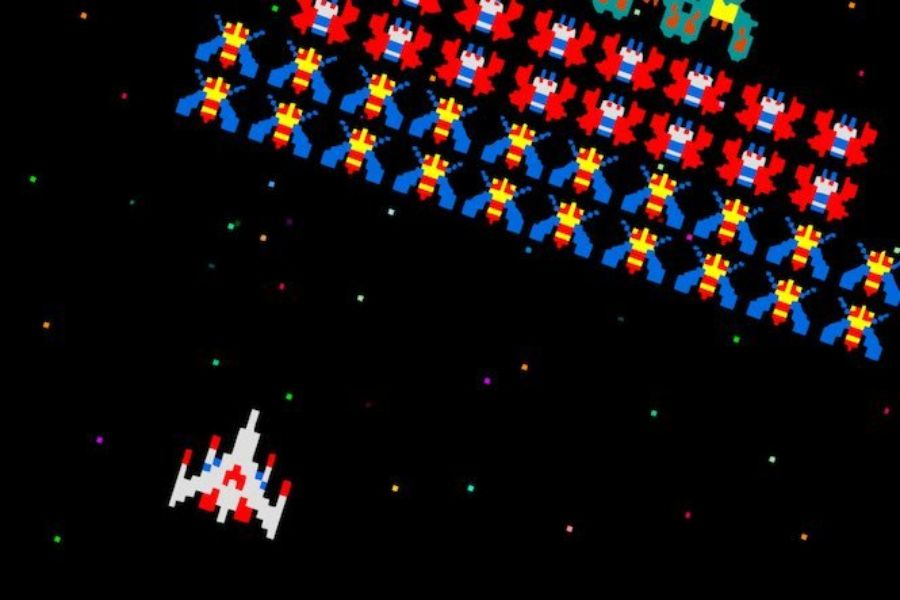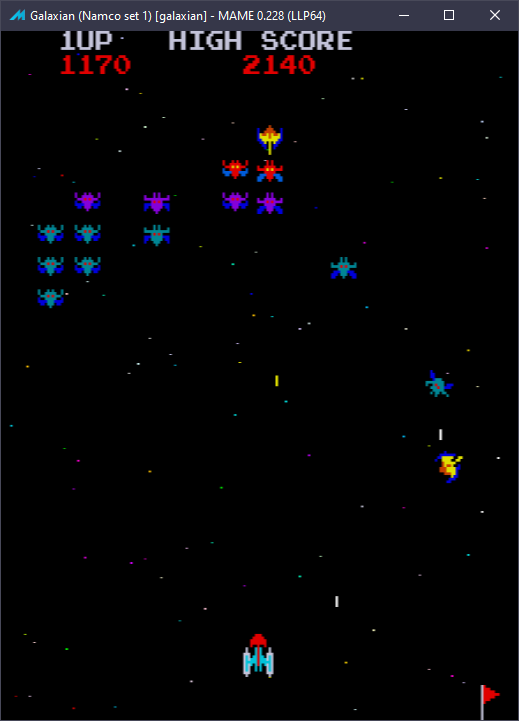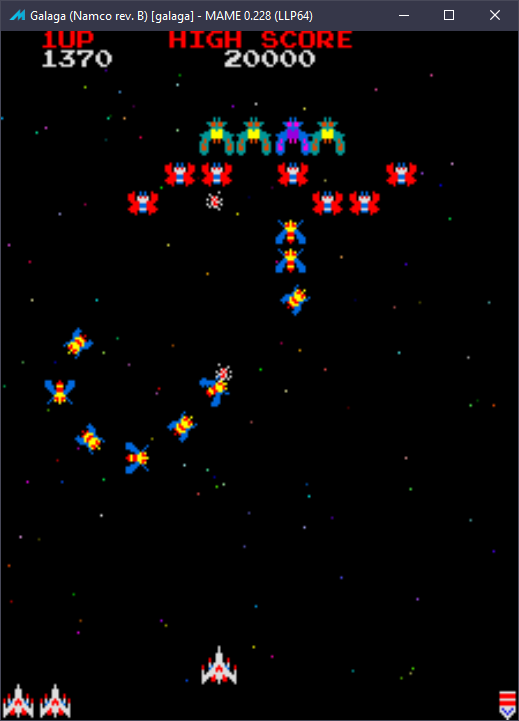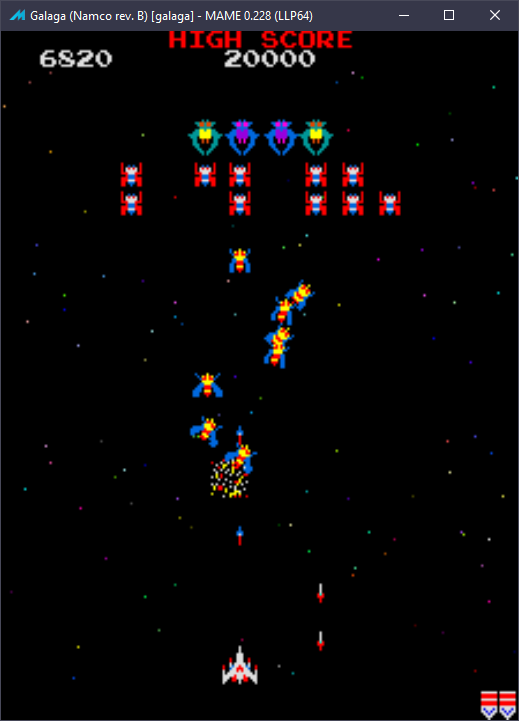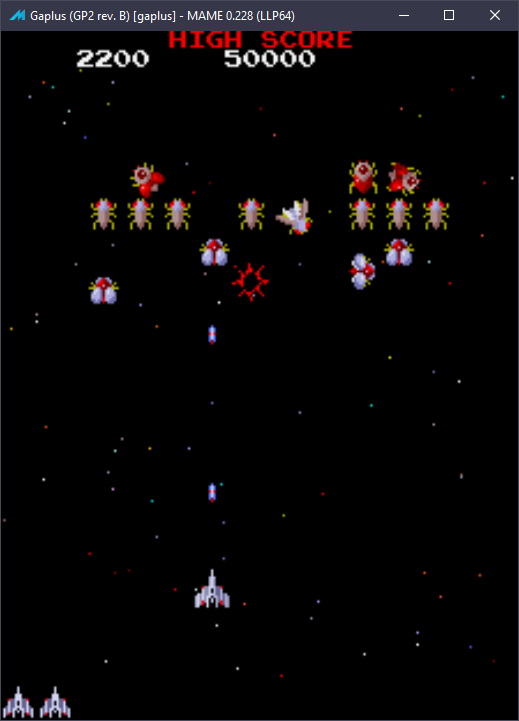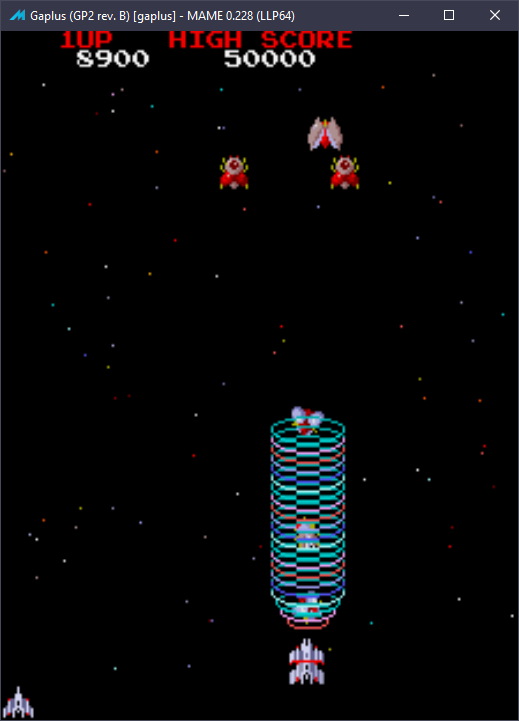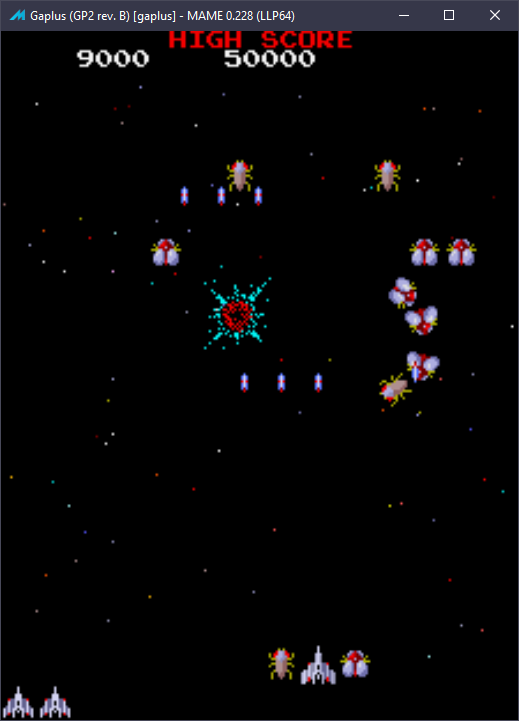The first times I played Galaga was when trying out Tekken 1 for the first time years ago, as the PS1 version had some of the game included for the initial loading screen. I also remember playing snippets of Galaxian and Galaga in Ridge Racer and Ridge Racer Revolution for PS1 respectively (in the same way as Tekken, starting loading screens), and then playing a lot of the NES version of Galaga through an emulator.
While Galaxian is relatively simple nowadays, it still keeps a sense of fun that is trademark from Namco's earliest hits, and its two inmediate sequels (Galaga/Gaplus) add some extra tweaks to the formula, cementing a base for future games to build a solid genre. I'll be talking about all three back-to-back here as they are pretty similar for today standards.
Galaxian was released in 1979 and had a simple premise: Move from side to side and shoot bullets to destroy all aliens, which will move from side to side. The game does look pretty simple, but it immediately sets for a challenge as enemies can dive against you at any moment and fire at you (you'll also die if you crash against them), and you can only fire as long as there isn't a bullet from you on-screen (enemies don't have this limitation).
Revisiting this game for the first time after a while definitely gave me a bigger perspective about why this game was such a success (aside from being innovative for the very early years of videogames); just like Pac-Man, it manages to set a curve of difficulty, as enemies can dive in many ways and speeds (and the yellow enemies called "Flagships" will always dive with two red aliens at the same time).
Galaga was an immediate sequel to Galaxian released in 1981, and ended up much more iconic than Galaxian from the few key additions it received. The game objective stays the same, but now enemies have different sprites and come flying in with specific patterns and then staying in positions similar to Galaxian (complete with diving), and you can now shoot up to 2 bullets at a time, which is extremely useful to clearing enemies before they even stay at the screen. The enemy that replaces the Flagship from Galaxian also can dive with two more enemies, but will try to capture you using a beam instead of crashing into you. You will lose a life if they do...but rescuing the ship by shooting at the enemy while diving at you will let you have dual fighters, being able to fire two bullets instead of one at the same time (for a total ot four at a screen).
While the enemies can still catch you off guard, it is an easier game to get into as you get a chance to kill enemies early and having two bullets (which is one likely factor about why Galaga vastly surpassed the original Galaxian in popularity). There's also the Challenging Stages between every two levels where enemies will fly through patterns and leave out of the screen; you can get bonuses including a double laser if you get Perfect on these stages by killing all enemies before they escape.
Gaplus was released in 1984 and added some few changes to the formula. Most notably, you can now move up and down instead of just left and right, enemies act similar to Galaxian in the first stages but move around a bit more (and move/dive much faster), and there's a new special enemy that can hold ship upgrades obtained by shooting it down ONLY while its diving. However, sometimes the wind direction can change (indicated by the background scrolling changing direction and startnig to hear music) which will have a barrage of enemy patterns fly through before the stage begins properly.
One of the upgrades you can get (which is always the first one found) is a capturing beam that will grab any enemy that touches it (any that dives), and then turn them into turrets that are in your side, allowing you to shoot more bullets at a time. Challenging Stages are back, this time around having to juggle enemy by shooting them (but note that they will disappear if they got off-screen...including if you hit or juggle them until they leave by the top).
There is something very charming about these games despite their simplicity compared to games nowadays (though that by itself might be what can make these so easy to get caught into, as they virtually require no previous experience to pick up and play, yet offer a challenge of precision and dodging the enemies (as well as taking advantage of any powerups). While this was somewhat short, it was quite sweet to try these games out again and write about the simple ways they managed fun, and Namco definitely had this series (specially Galaga) as one of their earliest strong hitters along with Pac-Man, Xevious and Mappy.
Just the idea of anyone watching the game being able to understand what it is about does speak about how clean the game is (and that most could easily recognize these games also speaks about their iconic status in pop culture), and of course they did enjoy ports in many old consoles and compilations (Gaplus actually received a port to the NES in 2020 as part of a modern compilation).
Thank you so much for reading! If you'd like to see more arcade game reviews (or if you want me to take a shot at some other old Namco classics, or the other few sequels that came out after these three), let me know at the comments!
Spanish translation with DeepL. All screenshots were captured by myself.
Español
Las primeras veces que jugué a Galaga fue al probar Tekken 1 por primera vez hace años, ya que la versión de PS1 tenía algo del juego incluido para la pantalla de carga inicial. También recuerdo haber jugado a fragmentos de Galaxian y Galaga en Ridge Racer y Ridge Racer Revolution para PS1 respectivamente (de la misma forma que Tekken, con pantallas de carga iniciales), y luego haber jugado mucho a la versión de NES de Galaga a través de un emulador.
Aunque Galaxian es relativamente sencillo hoy en día, sigue manteniendo la sensación de diversión que caracteriza a los primeros éxitos de Namco, y sus dos secuelas inmediatas (Galaga/Gaplus) añaden algunos retoques adicionales a la fórmula, cimentando una base para que los futuros juegos construyan un género sólido. Aquí hablaré de los tres de forma consecutiva, ya que son bastante similares para los estándares actuales.
Galaxian salió a la venta en 1979 y tenía una premisa muy sencilla: moverse de lado a lado y disparar balas para destruir a todos los alienígenas, que se moverán de lado a lado. El juego parece bastante sencillo, pero enseguida supone un reto, ya que los enemigos pueden lanzarse contra ti en cualquier momento y dispararte (también morirás si chocas contra ellos), y sólo puedes disparar mientras no haya una bala tuya en pantalla (los enemigos no tienen esta limitación).
Revisar este juego por primera vez después de un tiempo definitivamente me dio una mayor perspectiva acerca de por qué este juego fue un éxito (aparte de ser innovador para los primeros años de los videojuegos); al igual que Pac-Man, logra establecer una curva de dificultad, ya que los enemigos pueden sumergirse de muchas maneras y velocidades (y los enemigos amarillos llamados "Flagships" siempre se sumergirán con dos alienígenas rojos al mismo tiempo).
Galaga fue una secuela inmediata de Galaxian lanzada en 1981, y acabó siendo mucho más icónico que Galaxian por los pocos añadidos clave que recibió. El objetivo del juego sigue siendo el mismo, pero ahora los enemigos tienen sprites diferentes y llegan volando con patrones específicos y se quedan en posiciones similares a las de Galaxian (completadas con inmersiones), y ahora puedes disparar hasta 2 balas a la vez, lo que es extremadamente útil para eliminar a los enemigos antes incluso de que se queden en la pantalla. El enemigo que sustituye a la nave insignia de Galaxian también puede bucear con dos enemigos más, pero intentará capturarte usando un rayo en lugar de chocar contigo. Perderás una vida si lo hacen... pero si rescatas la nave disparando al enemigo mientras se zambulle hacia ti, podrás tener cazas duales, pudiendo disparar dos balas en lugar de una al mismo tiempo (para un total de cuatro en una pantalla).
Aunque los enemigos pueden seguir cogiéndote desprevenido, es un juego más fácil de introducir, ya que tienes la oportunidad de matar a los enemigos pronto y tener dos balas (que es uno de los posibles factores por los que Galaga superó ampliamente al Galaxian original en popularidad). También están las Etapas Desafiantes entre cada dos niveles en las que los enemigos volarán a través de patrones y saldrán de la pantalla; puedes obtener bonificaciones, incluyendo un láser doble, si consigues la perfección en estas etapas matando a todos los enemigos antes de que escapen.
Gaplus fue lanzado en 1984 y añadió algunos cambios a la fórmula. En particular, ahora puedes moverte hacia arriba y hacia abajo en lugar de sólo hacia la izquierda y la derecha, los enemigos actúan de forma similar a los de Galaxian en las primeras fases, pero se mueven un poco más (y se mueven/salen mucho más rápido), y hay un nuevo enemigo especial que puede retener las mejoras de la nave que se obtienen disparándole SÓLO mientras se sumerge. Sin embargo, a veces la dirección del viento puede cambiar (indicado por el desplazamiento de fondo que cambia de dirección y se empieza a escuchar la música) lo que hará que un aluvión de patrones de enemigos vuele antes de que la etapa comience correctamente.
Una de las mejoras que puedes conseguir (que siempre es la primera que se encuentra) es un rayo de captura que agarrará a cualquier enemigo que lo toque (cualquiera que se sumerja), y luego los convertirá en torretas que estarán a tu lado, permitiéndote disparar más balas a la vez. Vuelven las etapas desafiantes, esta vez teniendo que hacer malabares con los enemigos disparándoles (pero ten en cuenta que desaparecerán si se salen de la pantalla... incluso si los golpeas o haces malabares con ellos hasta que salgan por arriba).
Hay algo muy encantador en estos juegos a pesar de su simplicidad en comparación con los juegos de hoy en día (aunque eso por sí mismo puede ser lo que puede hacer que estos sean tan fáciles de atrapar, ya que prácticamente no requieren experiencia previa para recoger y jugar, sin embargo, ofrecen un reto de precisión y esquivar a los enemigos (así como el aprovechamiento de cualquier powerups). Aunque fue algo corto, fue bastante dulce volver a probar estos juegos y escribir sobre las formas sencillas en que lograban la diversión, y Namco definitivamente tenía esta serie (especialmente Galaga) como uno de sus primeros éxitos fuertes junto con Pac-Man, Xevious y Mappy.
La sola idea de que cualquiera que vea el juego sea capaz de entender de qué se trata habla de lo limpio que es el juego (y que la mayoría pueda reconocer fácilmente estos juegos también habla de su estatus icónico en la cultura pop), y por supuesto disfrutaron de ports en muchas consolas antiguas y compilaciones (Gaplus de hecho recibió un port a la NES en 2020 como parte de una compilación moderna).
¡Muchas gracias por leer! Si queréis ver más análisis de juegos arcade (o si queréis que me dedique a otros clásicos de Namco, o a las pocas secuelas que salieron después de estos tres), hacédmelo saber en los comentarios!
Traducción al español hecha con DeepL. Todas las fotos capturadas por mí.
